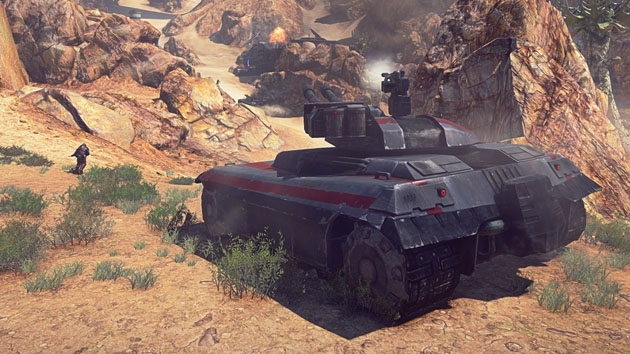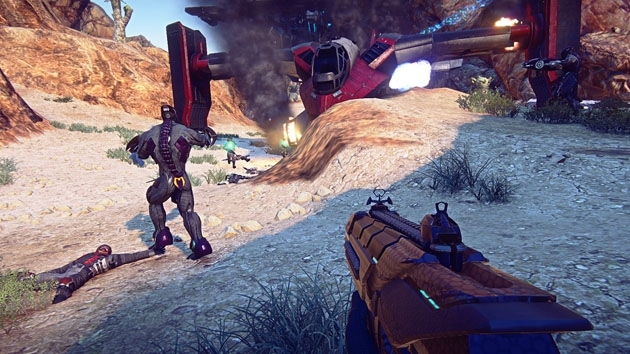ZAM Interview: The Power of ForgeLight
While at GDC, Scott Hawkes interviewed Planetside 2's Senior Art Director Tramell Ray Isaac and Technical Director Ryan Elam.

I asked Elam if there had been any major issues with the engine that had arisen due to the players buffeting it since launch, something that hadn’t been anticipated.
“I don’t think we had anything was a major one, anything that was a problem we knew going in. This is a team of coders where this is their third or fourth MMO. We’ve got coders from the original PlanetSide 1, we’ve got coders who started with EverQuest; we’ve got some really bright people and that’s the core of the ForgeLight engine, several hundred years of experience combined with the coders.
We have had some of those problems in the past, shipping an engine, and we expected to have several thousand players on a server and things blow up, things explode. We learn from those; they’re very painful lessons, we still bear the scars.
When PlanetSide 2 shipped I think the launch was very smooth. Other than client side performance, the servers pretty much had no problem whatsoever, they just kept cranking on.
In beta I think we had two server crashes during all of beta and those we fixed literally within half an hour. Another part of the ForgeLight engine is our ability to iterate on things really, really quickly; the designer iterating on Hossin having something to see that’s a continent within days and then just continuing to churn and iterate and work to beautify that terrain. All the way up to our servers when within minutes of a server crashing, we’re already pretty sure what the problem is and can start working on it.
To our client, where we get so much data from players, where things aren’t going the way we want, we see it very quickly; it’s not a surprise. We don’t have to wait for Reddit, though we do appreciate people going on to Reddit or on our forums and saying “here’s a problem”, but generally speaking we’re already seeing the problem, most of the time.
There hasn’t really been a major “Holy cow, what are we doing?” kind of a thing, it’s more, for us, optimize, optimize, optimize.”

With the obvious potential for using ForgeLight with games beyond PlanetSide 2, I asked whether ForgeLight was created with the express intent that SOE was making an engine to build its company around.
You nailed it, that’s exactly right. Our pedigree coming from games like EverQuest and EverQuest II and everything in between was actually an engine per game. You wrote everything, you wrote toolset, you wrote servers. The coders would talk to each other and say “here’re some problems I ran into, make sure you don’t do this etc. etc.” but generally speaking it was “We are writing this new game, again.” That just doesn’t work, we want to make games not engines, so rallying a team around building an engine and then all the other coders are working on the game code, they don’t have to work on the engine code any more.
Predominantly, my coders on the PlanetSide 2 team can make PlanetSide instead of making ForgeLight. ForgeLight will continue to be iterated on and adding more features to as it goes further from game to game to game, but it’s essentially got the same core. The core that players don’t see but there are millions of lines of code that don’t actually make the game but make ForgeLight, make the back end, make the servers run. Nothing to do with gameplay just literally make them communicate with each other and talk to databases, talk to our back end, talk to our market places; there are tons of examples of that. We don’t have to rewrite that. We don’t have to retrain art directors on what they can and can’t do. They just go in and know what ForgeLight can do and work on what they want to work on.”
I suggested that the engine must streamline production to the extent that it must decrease turnaround time on development dramatically for SOE’s business plan.
Tramell: “One of the shining examples of that is PlanetSide 2; we made the launch game in about 18 months. As far as I know it’s been the shortest turnaround on any MMO that we’ve created in SOE history. It is an AAA title, a title that will compete with any other title out there that you would spend three to four years on. We have a core tech team that just works on ForgeLight and they facilitate the features that each group needs.
The tools are central to each team, but they’re also individual to each team. So they may need a certain aspect of their terrain tool that we don’t necessarily need but those things are dependent on each game that gets developed.
So [hypothetically] we’re making a fight game; and that fighting game would need a set of tools that we don’t need, but those things are outside of ForgeLight itself. ForgeLight is the core, everything else that facilitates a particular team is part of that team.”
As Tramell and Ryan joked about the possibilities for creating a new fighting MMO and we wrapped up the interview, thoughts beyond PlanetSide 2 regarding the ForgeLight engine must turn toward EQNext and the secrecy that enshrouds it.
I was told to get my jaw in training as it was implied that people have been known to sprain theirs when first introduced to EQNext.
August and SOE Live can’t come quickly enough.
PlanetSide 2 is, of course, available now and is free to play, where it continues to fill the skies with screeching aircraft, while the ground rumbles under the assault of tanks and infantry, all on the same screen.
Scott “Jarimor” Hawkes, Editor in Chief, Terran Republic



